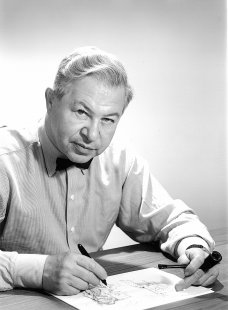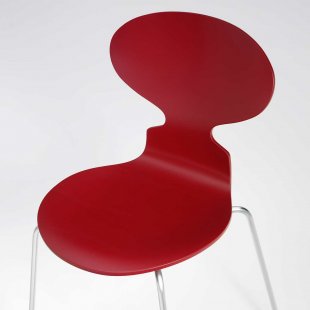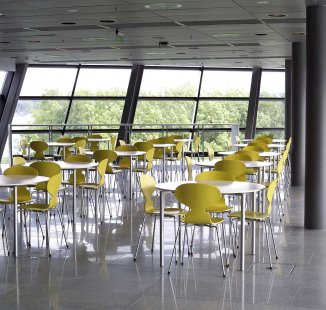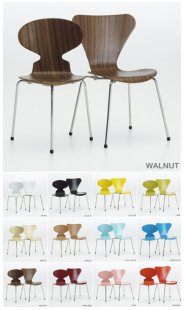
The Story of Scandinavian Modernity I.
Scandinavian design and the entire modernist movement would not be complete without Arne Jacobsen. And also Fritz Hansen, who allowed the Danish architect and designer to realize his designs.
It was not only Arne Jacobsen, but also Hans J. Wegner and Poul Kjærholm, who combined their talent with the Danish furniture maker Fritz Hansen. Together, they gave rise to a famous brand that has been synonymous with Danish design for over a hundred years. Scandinavian furniture makers not only popularized local craftsmanship but also new uses for wood, its innovative processing, and industrial production, which allows for the manufacture of large series of affordable furniture. What makes the IKEA chain so successful around the world today has its roots in manufacturers and designers like Fritz Hansen or Arne Jacobsen. They were the pioneers who paved the way and sought new processing possibilities for materials and new technologies.
The Beginning of the Family Business
The story begins in 1847, when the first Carlsberg brewery opened in Denmark and a railway line from Copenhagen to Roskilde was established. King Christian VIII ceremoniously opened it on July 26. It was also in that year that Fritz Hansen was born on the Danish island of Lolland. Skillful, ambitious, and very capable. This is how his contemporaries characterized the young man who opened his first shop at the age of 25. In 1896, his business expanded, and he bought his own workshop in the town of Lillerød, north of Copenhagen, where he began producing furniture. When his son Christian Edvard Hansen (1874-1954) took over the company in 1899, it had more than 50 employees.
The founder of the Fritz Hansen family business died at the age of 55, and in the same year, 1902, his first grandson Poul Fritz Hansen was born. The family business systematically transitioned from handmade production to industrial manufacturing.
At the beginning of the twentieth century, a new movement of functionalism began to awaken, particularly associated with the German Bauhaus. Technological progress and new materials aligned with the philosophy of the Hansen family. "Modern, progressive, and with refined taste"... these are basically the values that Fritz Hansen still adheres to today. Their more than a century-long tradition of furniture production shows that aesthetics and industrial manufacturing can coexist well.
As the very first in Denmark, the Fritz Hansen factory succeeded in producing a bent wood chair in 1915. During the 1920s and 1930s, the company introduced a collection of then modern and new tubular furniture, as known from designers like Marcel Breuer and Ludwig Mies van der Rohe. Similar furniture is produced in our country, for example, by the United Arts and Crafts Works in Brno according to the designs of Jindřich Halabala.
The Ant Arrives
In 1928, the two sons of Christian E. Hansen, Poul Fritz (1902-1987) and Sören Christian (1905-1977), joined the management of the company, marking a new important era in the long history of the Fritz Hansen brand. In 1934, the factory began cooperation with architect Kaare Klint and the then very young and talented Arne Jacobsen. The famous Ant chair was created, which Jacobsen designed for the restaurant of the Bellevue Theatre in Klampenborg, north of Copenhagen.
The Ant was the first and still the most famous chair designed by Arne Jacobsen. It is stackable, with a simple seat and backrest; originally, it had three legs, but a four-legged version was also produced concurrently. The name 'Ant' was coined by Jacobsen's friend Gunnar Aagaard Andersen, and over six million pieces have been sold to date. It ranks among the best-selling chairs of all time and embodies the concept of functionalism through mass production and accessibility for everyone. It is elegant and practical, thus used in offices and other public spaces (cafeterias, conference centers…) around the world.
Explore the complete portfolio of Fritz Hansen products on the design portal myCode or visit www.fritzhansen.com for complete information about this brand.
- To be continued next week -
It was not only Arne Jacobsen, but also Hans J. Wegner and Poul Kjærholm, who combined their talent with the Danish furniture maker Fritz Hansen. Together, they gave rise to a famous brand that has been synonymous with Danish design for over a hundred years. Scandinavian furniture makers not only popularized local craftsmanship but also new uses for wood, its innovative processing, and industrial production, which allows for the manufacture of large series of affordable furniture. What makes the IKEA chain so successful around the world today has its roots in manufacturers and designers like Fritz Hansen or Arne Jacobsen. They were the pioneers who paved the way and sought new processing possibilities for materials and new technologies.
The Beginning of the Family Business
The story begins in 1847, when the first Carlsberg brewery opened in Denmark and a railway line from Copenhagen to Roskilde was established. King Christian VIII ceremoniously opened it on July 26. It was also in that year that Fritz Hansen was born on the Danish island of Lolland. Skillful, ambitious, and very capable. This is how his contemporaries characterized the young man who opened his first shop at the age of 25. In 1896, his business expanded, and he bought his own workshop in the town of Lillerød, north of Copenhagen, where he began producing furniture. When his son Christian Edvard Hansen (1874-1954) took over the company in 1899, it had more than 50 employees.
The founder of the Fritz Hansen family business died at the age of 55, and in the same year, 1902, his first grandson Poul Fritz Hansen was born. The family business systematically transitioned from handmade production to industrial manufacturing.
At the beginning of the twentieth century, a new movement of functionalism began to awaken, particularly associated with the German Bauhaus. Technological progress and new materials aligned with the philosophy of the Hansen family. "Modern, progressive, and with refined taste"... these are basically the values that Fritz Hansen still adheres to today. Their more than a century-long tradition of furniture production shows that aesthetics and industrial manufacturing can coexist well.
As the very first in Denmark, the Fritz Hansen factory succeeded in producing a bent wood chair in 1915. During the 1920s and 1930s, the company introduced a collection of then modern and new tubular furniture, as known from designers like Marcel Breuer and Ludwig Mies van der Rohe. Similar furniture is produced in our country, for example, by the United Arts and Crafts Works in Brno according to the designs of Jindřich Halabala.
The Ant Arrives
In 1928, the two sons of Christian E. Hansen, Poul Fritz (1902-1987) and Sören Christian (1905-1977), joined the management of the company, marking a new important era in the long history of the Fritz Hansen brand. In 1934, the factory began cooperation with architect Kaare Klint and the then very young and talented Arne Jacobsen. The famous Ant chair was created, which Jacobsen designed for the restaurant of the Bellevue Theatre in Klampenborg, north of Copenhagen.
The Ant was the first and still the most famous chair designed by Arne Jacobsen. It is stackable, with a simple seat and backrest; originally, it had three legs, but a four-legged version was also produced concurrently. The name 'Ant' was coined by Jacobsen's friend Gunnar Aagaard Andersen, and over six million pieces have been sold to date. It ranks among the best-selling chairs of all time and embodies the concept of functionalism through mass production and accessibility for everyone. It is elegant and practical, thus used in offices and other public spaces (cafeterias, conference centers…) around the world.
Explore the complete portfolio of Fritz Hansen products on the design portal myCode or visit www.fritzhansen.com for complete information about this brand.
- To be continued next week -
The English translation is powered by AI tool. Switch to Czech to view the original text source.




0 comments
add comment












